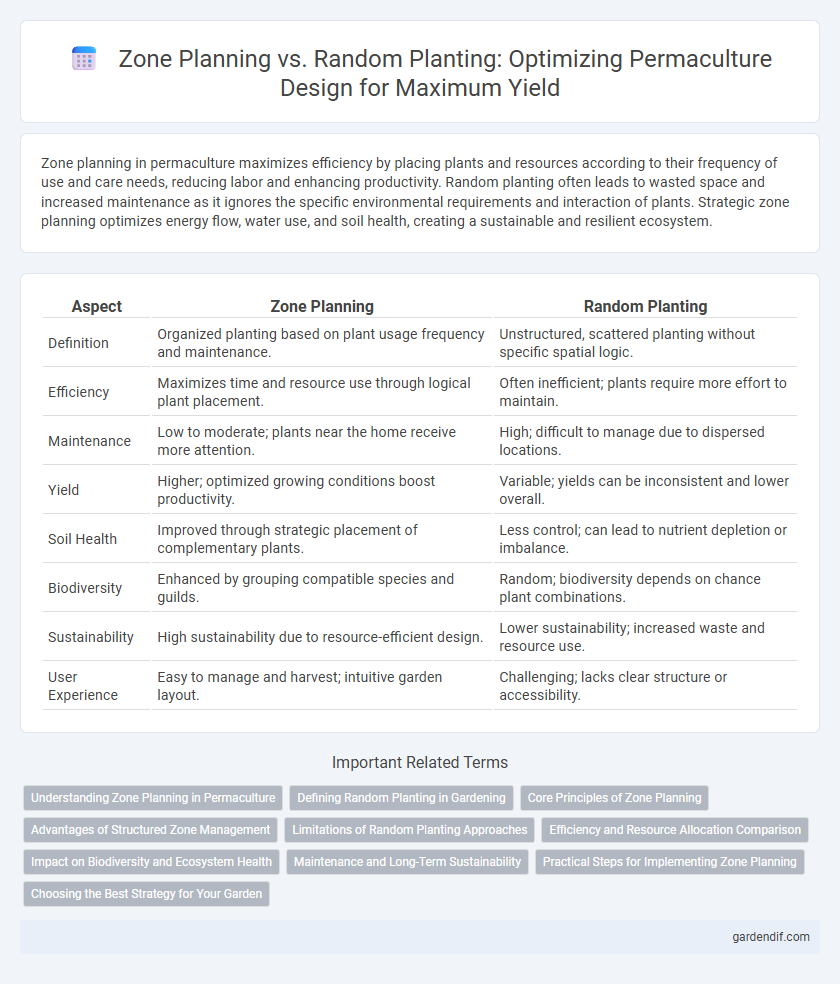
Zone Planning vs Random Planting Illustration
Zone planning in permaculture maximizes efficiency by placing plants and resources according to their frequency of use and care needs, reducing labor and enhancing productivity. Random planting often leads to wasted space and increased maintenance as it ignores the specific environmental requirements and interaction of plants. Strategic zone planning optimizes energy flow, water use, and soil health, creating a sustainable and resilient ecosystem.
Table of Comparison
| Aspect | Zone Planning | Random Planting |
|---|---|---|
| Definition | Organized planting based on plant usage frequency and maintenance. | Unstructured, scattered planting without specific spatial logic. |
| Efficiency | Maximizes time and resource use through logical plant placement. | Often inefficient; plants require more effort to maintain. |
| Maintenance | Low to moderate; plants near the home receive more attention. | High; difficult to manage due to dispersed locations. |
| Yield | Higher; optimized growing conditions boost productivity. | Variable; yields can be inconsistent and lower overall. |
| Soil Health | Improved through strategic placement of complementary plants. | Less control; can lead to nutrient depletion or imbalance. |
| Biodiversity | Enhanced by grouping compatible species and guilds. | Random; biodiversity depends on chance plant combinations. |
| Sustainability | High sustainability due to resource-efficient design. | Lower sustainability; increased waste and resource use. |
| User Experience | Easy to manage and harvest; intuitive garden layout. | Challenging; lacks clear structure or accessibility. |
Understanding Zone Planning in Permaculture
Zone planning in permaculture strategically organizes plants and resources based on their frequency of use and care needs, enhancing efficiency and sustainability within the system. By placing high-maintenance crops like herbs and vegetables in Zone 1, closest to the home, and less-tended areas such as orchards or woodlots in outer zones, practitioners optimize energy and time management. This method contrasts with random planting by reducing labor, improving yields, and creating a harmonious ecosystem tailored to natural patterns and human interaction.
Defining Random Planting in Gardening
Random planting in gardening involves placing plants without a structured layout, leading to inefficient use of space and resources. Unlike permaculture's zone planning, which strategically situates plants based on frequency of care and ecological functions, random planting often results in increased maintenance and reduced productivity. This unorganized approach can disrupt natural interactions between plants, pests, and beneficial insects, hindering sustainable ecosystem management.
Core Principles of Zone Planning
Zone planning in permaculture organizes plants based on their frequency of use and maintenance needs, optimizing energy and resource efficiency. Core principles include placing high-maintenance or frequently harvested plants in Zone 1, nearest to the home, while less demanding plants occupy outer zones, reducing unnecessary labor and travel time. This strategic placement enhances sustainability by maximizing yield, minimizing waste, and fostering harmonious ecosystem interactions.
Advantages of Structured Zone Management
Structured zone planning in permaculture enhances resource efficiency by designating plants and activities based on their frequency of use and maintenance needs, reducing labor and energy expenditure. This method improves ecosystem health by concentrating nutrient-demanding plants near composting areas and water sources, promoting natural cycles and biodiversity. Organized space allocation in zone planning maximizes productivity and supports sustainable long-term garden management compared to random planting.
Limitations of Random Planting Approaches
Random planting approaches in permaculture often lead to inefficient resource use, poor plant health, and increased maintenance due to lack of strategic placement based on plant needs and interactions. This method fails to optimize sunlight exposure, water distribution, and soil fertility, resulting in lower yields and higher vulnerability to pests. Zone planning mitigates these issues by organizing plants according to their function and frequency of use, enhancing ecosystem resilience and productivity.
Efficiency and Resource Allocation Comparison
Zone planning in permaculture maximizes efficiency by strategically placing plants and resources according to their frequency of use, reducing labor and energy expenditure. Random planting often results in resource misallocation, leading to increased water, nutrient, and time consumption due to inefficient plant spacing and accessibility. Effective zone design optimizes resource allocation and enhances overall productivity by aligning plant needs with human interaction zones.
Impact on Biodiversity and Ecosystem Health
Zone planning in permaculture strategically groups plants based on their maintenance needs and interactions, enhancing biodiversity by fostering complementary species and creating diverse habitats. Random planting lacks deliberate spatial organization, often leading to resource competition and reduced ecosystem resilience. By optimizing plant placement, zone planning promotes soil health, pest control, and pollinator support, resulting in a more balanced and sustainable ecosystem.
Maintenance and Long-Term Sustainability
Zone planning in permaculture strategically places plants based on their maintenance needs and frequency of use, reducing labor and resource consumption over time. Random planting increases unpredictability in care requirements, often leading to inefficiencies and higher maintenance efforts. Effective zone planning enhances long-term sustainability by optimizing water use, soil health, and ecological balance within the garden ecosystem.
Practical Steps for Implementing Zone Planning
Zone planning in permaculture organizes plants and activities based on their frequency of use and maintenance needs, increasing efficiency and reducing labor. Practical steps include mapping your property into distinct zones from 0 (home) to 5 (wilderness), placing high-maintenance plants like herbs and vegetables close to the house in Zones 1 and 2, and situating less tended plants such as fruit trees and timber further out in Zones 3 and beyond. This method optimizes resource use, harvest yields, and minimizes unnecessary movement, contrasting sharply with random planting that often leads to wasted time and energy.
Choosing the Best Strategy for Your Garden
Zone planning in permaculture involves organizing plants based on their frequency of use and maintenance needs, creating efficient energy flow and minimizing labor. Random planting lacks this structured approach, often leading to wasted space and resources due to mismatched plant requirements. Selecting zone planning maximizes yield and sustainability by aligning garden design with ecological principles and daily habits.
Zone Planning vs Random Planting Infographic

 gardendif.com
gardendif.com